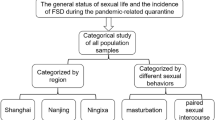Abstract
The frequency of sexual dysfunction (SD) is not very well known in patients with chronic hepatitis C. In this study, the prevalence of SD and its correlations with psychological and biological variables was assessed in 46 HCV positive patients. The mean age of patients was 46.4±9.4 y; the mean duration of HCV infection was 43.4±34.0 months; 52% were male; 89% were living with a spouse. SD was assessed using the Arizona Sexual Experiences Scale (ASEX), the level of anxiety and depression measured with the Hospital Anxiety and Depression Scale (HADS). Biochemical parameters were also assessed. Overall, as indicated by ASEX criteria, SD was observed in 35% of our patients. Of 24 males, 21% described SD; problems with drive (25%), arousal (17%) and erection (17%) were the most frequent complaints. Of 22 female patients, 50% described SD; problems with drive (55%) arousal (50%), and reaching orgasm (59%) were the most frequent complaints. Total ASEX scores were correlated with age (P<0.07, significant at trend level), education (P<0.001), and was higher in female patients (P<0.02). After controlling for the effects of age, sex, education, duration of HCV and marital status, depression levels could still significantly predict the SD (P<0.05). Moreover, even after controlling the effects of all other variables, gamma glutamyl transpeptidase (GGT) levels could predict the SD status of the patients (P<0.05). Our results indicate that the prevalence of SD was 35% in HCV-infected patients and the level of depression and GGT levels were predictive of patients SD status.
This is a preview of subscription content, access via your institution
Access options
Subscribe to this journal
Receive 8 print issues and online access
$259.00 per year
only $32.38 per issue
Buy this article
- Purchase on Springer Link
- Instant access to full article PDF
Prices may be subject to local taxes which are calculated during checkout

Similar content being viewed by others
References
Alter MJ et al. The prevalence of hepatitis C virus infection in the United States: 1994 through 1998. N Engl J Med 1999; 341: 556–562.
Page-Shafer KA et al. Hepatitis C infection in young, low-income women: the role of sexually transmitted infections as a potential cofactor for HCV infection. Am J Public Health 2002; 92: 670–676.
Valdivia JA et al. Hepatitis C virus infection in female sexual workers from northern Lima. Rev Gastroenterol Peru 2003; 23: 265–268.
Boonyarad V et al. Interspousal transmission of hepatitis C in Thailand. J Gastroenterol 2003; 38: 1053–1059.
Roonet G, Gison RJ . Sexual transmission of hepatitis C virus infection. Sex Transm Infect 1998; 74: 399–404.
Center for Disease Control and Prevention. Recommendations for prevention and control of hepatitis C virus (HCV) infection and HCV-related chronic disease. MMWR 1998; 47: 1–39.
Banwell C et al. Disturbingly low levels of contraception among women living with hepatitis C. Aust NZ J Public Health 2003; 27: 620–626.
Clavo P, Garcia S, Rodriguez C . Prevalence of STD, HIV and hepatitis markers, and risk behaviour in immigrant female sex workers in Madrid. In: Program and Abstracts of the XIV International AIDS Conference, Barcelona, Spain, International Conference on AIDS, 2002 Vol 14, Abstract C3489.
Ferri C, Bertozzi MA, Zignego AL . Erectile dysfunction and hepatitis C virus infection. JAMA 2002; 8: 698–699.
Marumo K, Nakashima J, Murai M . Age-related prevalence of erectile dysfunction in Japan: assessment by the International Index of Erectile Function. Int J Urol 2001; 8: 53–59.
McGahuey CA, Delgado LP, Geleberg AJ . Assessment of sexual dysfunction using the Arizona Sexual Experience Scale (ASEX) and implications for the treatment of depression. Psychiatr Ann 1999; 29: 39–45.
Zigmond AS, Snaith RP . The Hospital Anxiety and Depression Scale. Acta Psychiatry Scand 1983; 67: 361–370.
Soykan A . The reliability and validity of Arizona Sexual Experiences Scale in Turkish ESRD patients undergoing hemodialysis. Int J Impot Res, advance online publication 3 June 2004 doi:10.1038/sj.ijir.3901249.
Aydemir O et al. Hastane Anksiyete ve Depresyon Ölçeği. Turkce formunun geçerliliği ve güvenirliği karşılaştırması. Turk J Psychiatry 1997; 8: 280–287.
Sağduyu A et al. Sexual problems in patients at a primary health care clinic. Turk J Psychiatry 1997; 8: 220–226.
Kuloğlu M et al. Antidepresan ilaçların cinsel işlev üzerine etkileri. Bull Clin Psychopharmacol 2000; 10: 97–102.
Toorians AW, Giltay EJ, Donker AJM, Gooren LJG . Sexual functioning in chronic renal failure. Semin Dial 1997; 10: 176–181.
Piazza M et al. Long-term interferon-alpha therapy does not affect sex hormones in males with chronic hepatitis C. J Interferon Cytokine Res 1997; 17: 525–529.
Rhoads J . Natural history and epidemiology of hepatitis C. J Assoc Nurses AIDS Care 2003; 14(5 Suppl): 18S–25S.
Tahan V et al. Sexual transmission of HCV between spouses. J Hepatol 2003; 38(2 Suppl): 176.
Author information
Authors and Affiliations
Corresponding author
Rights and permissions
About this article
Cite this article
Soykan, A., Boztaş, H., İdilman, R. et al. Sexual dysfunctions in HCV patients and its correlations with psychological and biological variables. Int J Impot Res 17, 175–179 (2005). https://doi.org/10.1038/sj.ijir.3901267
Received:
Revised:
Accepted:
Published:
Issue Date:
DOI: https://doi.org/10.1038/sj.ijir.3901267
Keywords
This article is cited by
-
Endocrine disorders associated with hepatitis C virus chronic infection
Reviews in Endocrine and Metabolic Disorders (2018)
-
Sexual quality of life is impaired in patients with chronic hepatitis C
International Journal of Impotence Research (2016)
-
Spirulina platensis versus silymarin in the treatment of chronic hepatitis C virus infection. A pilot randomized, comparative clinical trial
BMC Gastroenterology (2012)
-
Comprehensive Self-Management Reduces the Negative Impact of Irritable Bowel Syndrome Symptoms on Sexual Functioning
Digestive Diseases and Sciences (2012)
-
Male sexual disturbances in liver diseases: What do we know?
Journal of Endocrinological Investigation (2010)


